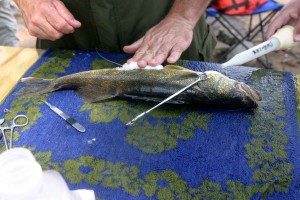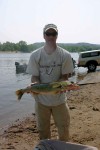By Tony Graf tgraf@stmedianetwork.com June 29, 2011 8:38PM
Updated: June 30, 2011 8:34AM
BRACEVILLE — Braidwood Lake has more than 80 new artificial fish habitats, thanks to a team effort Wednesday by Exelon Nuclear, local anglers and a state agency.
The habitats complement a five-year-long stocking effort that has added more than 310,000 fingerling largemouth bass to the lake, said Rob Miller, district fisheries biologist for the Illinois Department of Natural Resources.
Braidwood Lake is a cooling lake for Braidwood Generating Station, an Exelon Nuclear power plant. Created from flooded strip-mine pits, the lake hosts Exelon’s Fishing for a Cure program each year.
The artificial habitats provide multiple benefits to largemouth bass — a favorite of Midwest anglers — at various stages in the fishes’ lives, Exelon said in a Wednesday news release. The units will act as nursery habitats for young fish and feeding sites for larger, older bass, the company said.
On Wednesday, anglers in fishing boats took off from the lake’s north ramp, headed for numerous destinations around the 2,500-acre cooling lake.
When the anglers found the right places, they simply tossed the lightweight habitats into the water and let them sink to the bottom.
When the habitat reaches the bottom, silt covers the edges of the base so the habitat will settle in that location. It is designed for stability in a riverlike setting, said Jeff Jenkins, of Jenkins & Son LLC from downstate Marion.
Jenkins designed the habitat and gave a presentation Wednesday at the Department of Natural Resources office on Huston Road in Braceville.
The habitat’s base has several vertical cylindrical bars extending upward — informally called “stickups,” Jenkins said.
These stickups will green over with algae within a few days, and zooplankton will start feeding on the algae immediately, he said. This is the first step in creating the desired underwater ecosystem.
Small fish will seek these habitats. Spawning will occur there. And eventually, the habitats will draw the bigger fish, Jenkins said.
The habitats are useful for attracting additional game fish other than bass, he said.
On Wednesday, anglers added 88 habitat units to those deployed in previous efforts. The crews were joined by the DNR’s Rob Miller and Neal Miller, spokesman for Exelon Nuclear.
“As habitats continue to be added and those previously deployed become seasoned, we’re providing habitat types that are attractive to these fish at various stages of their lives, from fingerlings to adults,” Rob Miller said. “The proof is in the increased number of largemouth bass in IDNR surveys and a dramatic improvement in angling success rates.”
On the water
Kyle Danhausen of Kankakee took two local reporters around the lake in his boat Wednesday morning. During the first trip, the three-man crew dropped 12 units in a small channel off a larger channel midlake.
The larger channel has warmer water, and fish take refuge in the cooler water of these side channels.
On the second trip, the crew dropped 12 more units in water 6 feet to 7 feet deep near a shoreline.
Danhausen used his trolling motor to navigate along the shore. There is no bottom structure here, and the water is around 90 degrees, he said.
Milfoil and other aquatic vegetation once was abundant here, providing a habitat for bass. An angler could catch plenty of fish above the weeds, within the weeds or in pockets of open water.
In the mid-1990s, the Braidwood Generating Station started running at a higher capacity, warming the water in the cooling lake. Vegetation started to die, and the fishery declined.
The stocking effort and artificial habitats are bringing back the fishery because the habitats replace some of the green that was lost, which the fish need to thrive, Exelon’s Neal Miller said.
Team effort
Exelon Nuclear and the Department of Natural Resources teamed up with many anglers Wednesday. The effort included members of the American Bass Anglers, Bass PAC, Fishers of Men, and the National Bass Anglers Association. Shimano American Corp. also was represented.
“The efforts of Braidwood Station and IDNR are making a difference,” said Jay O’Connell, a member of the American Bass Anglers and Bass PAC. “We are seeing a tremendous increase in keepers (tournament-length fish) over just a few years ago. The results speak for themselves.”
Dan Enright, Braidwood station site vice president, said: “Thanks go to the American Bass Anglers, Bass PAC and the IDNR for helping us with this important environmental project. Their knowledge of the lake and expertise in the area of bass fishing is critical to our success.”
Exelon and the three groups mentioned by Enright have been working for five years to enhance the fishing experience at Braidwood Lake. The five-year project cost is $25,000.
See the dozens of unique artificial fish habitat models, fish attractors and fish cover used at fishiding.com, the industry leader and only science based, man made and artificial fish habitat, proven to provide all fish with cover they prefer to prosper.







 A $1.6 MILLION fish passage was to be built at the east end (right) of the Bridge Street dam in Grafton as part of Ozaukee County’s Milwaukee River fish habitat restoration project. The plan, however, has been rejected by the Department of Natural Resources.
A $1.6 MILLION fish passage was to be built at the east end (right) of the Bridge Street dam in Grafton as part of Ozaukee County’s Milwaukee River fish habitat restoration project. The plan, however, has been rejected by the Department of Natural Resources.